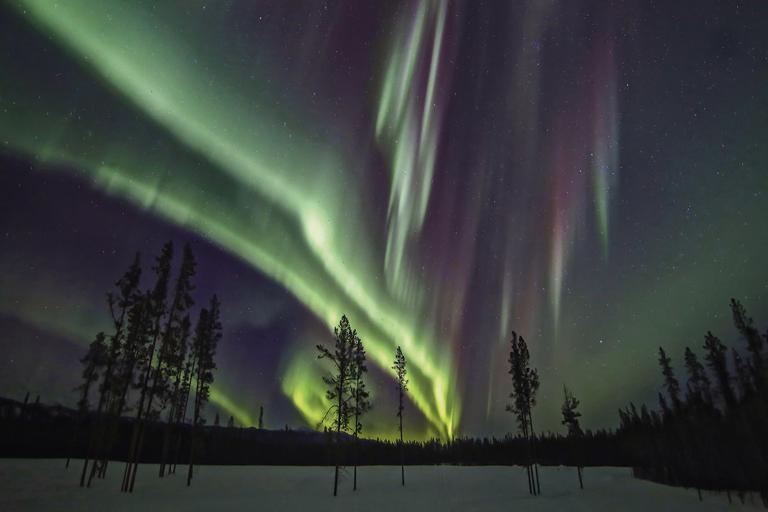Exploring Northern Lights Hotspots Across Yukon’s Expansive Wilderness
Travelers seeking dramatic aurora displays are flocking to Yukon, where clear skies, remote lodges, and guided nighttime excursions are helping visitors experience some of the country’s most vivid natural phenomena.
By Noah Wilson · November 12, 2025 19:22

Visitors from across Canada and around the world are traveling north to experience the breathtaking aurora borealis displays that illuminate the Yukon’s expansive wilderness each winter. The region’s vast open skies, minimal light pollution, and pristine landscapes make it one of the most reliable destinations for night sky viewing. Tour operators report steadily increasing interest as travelers seek immersive, nature-focused experiences that highlight the northern lights in their full brilliance.
Many travelers begin their journey in Whitehorse, where guided expeditions provide transportation, photography assistance, and scientific context about the aurora. Experienced guides help visitors understand how solar particles interact with Earth’s magnetic field to create vibrant waves of green, purple, and red light. These explanations often take place around heated shelters or campfires, creating a memorable blend of education and comfort in the subarctic cold.
One of the strongest appeals of the Yukon’s aurora season is its unpredictability. Even with modern forecasting tools, no two nights are alike. Visitors describe moments of anticipation as they scan the horizon, waiting for the first faint glow to ripple across the sky. When the aurora finally bursts into full display, the experience is often described as overwhelming, peaceful, and deeply humbling.
Remote lodges outside city centers offer some of the most sought-after viewing conditions. These establishments often provide cozy accommodations, hot beverages, and outdoor viewing decks where guests can watch the lights unfold in near silence. Many lodges emphasize sustainability, encouraging low-impact tourism that preserves the natural integrity of the surrounding wilderness.
Photographers are particularly drawn to the Yukon’s aurora season. The region offers clear vantage points with dramatic foregrounds that include frozen lakes, snow-covered forests, and mountain silhouettes. Workshops led by professional photographers teach participants how to capture long-exposure images, adjust camera settings, and frame compelling compositions despite frigid temperatures.
For travelers seeking adventure, some tours incorporate nighttime snowshoeing, dogsledding, or snowmobiling before settling in to watch the sky. These activities give participants a chance to explore the terrain and connect with northern culture before the aurora viewing begins. Guides emphasize safety and preparation, ensuring visitors are equipped with proper gear for subzero conditions.
Local Indigenous communities contribute cultural perspectives to some tours, sharing traditional stories and teachings about the northern lights. These insights offer visitors a deeper understanding of the aurora’s significance across generations. Many guests describe these moments as some of the most meaningful parts of their trip, highlighting the importance of cultural respect and collaboration.
Businesses in the territory have seen steady growth as winter tourism expands. Hotels, cafés, and outfitters report increased demand during aurora season, helping stabilize the local economy during months that were once considered off-season. This growth has encouraged continued investment in infrastructure and visitor services.
Environmental stewardship remains a priority as tourism increases. Operators work to minimize ecological impact by limiting group sizes, encouraging proper waste disposal, and supporting conservation initiatives. Many emphasize the importance of respecting wildlife habitats and maintaining the Yukon’s reputation as a pristine wilderness destination.
Visitors often say the northern lights offer a rare sense of perspective, prompting reflection and emotional connection. The sheer scale and beauty of the aurora can evoke feelings of wonder that stay with travelers long after they return home. Such reactions highlight the Yukon’s unique ability to inspire through its natural environment.
Scientists continue to study the aurora from research stations across northern Canada, examining variability in solar activity and atmospheric conditions. These studies not only support tourism but also contribute to broader scientific understanding. Visitors are often fascinated to learn how global space weather affects the northern lights they are witnessing.
As climate conditions shift, experts are monitoring potential impacts on aurora visibility. While the lights themselves are driven by solar activity, cloud cover, seasonal changes, and atmospheric patterns can influence viewing quality. Researchers stress the importance of ongoing data collection to anticipate changes and protect the region’s tourism industry.
Despite the uncertainties, one thing remains clear: the Yukon continues to offer an unparalleled opportunity to witness one of nature’s most spectacular phenomena. With thoughtful planning, collaborative stewardship, and a deep respect for the land, the region is poised to remain a world-class destination for aurora seekers well into the future.